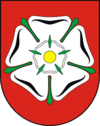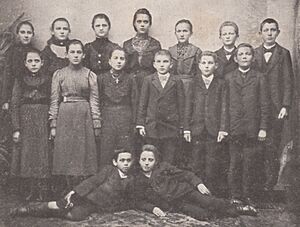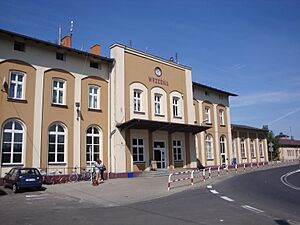Września facts for kids
Quick facts for kids
Września
|
|||
|---|---|---|---|
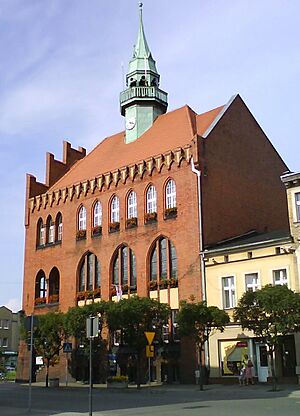
Town hall
|
|||
|
|||
| Country | |||
| Voivodeship | Greater Poland | ||
| County | Września | ||
| Gmina | Września | ||
| First mentioned | 1256 | ||
| Town rights | 1375 | ||
| Area | |||
| • Total | 12.73 km2 (4.92 sq mi) | ||
| Highest elevation | 110 m (360 ft) | ||
| Lowest elevation | 90 m (300 ft) | ||
| Population
(2021)
|
|||
| • Total | 29,483 | ||
| • Density | 2,316.0/km2 (5,998.5/sq mi) | ||
| Time zone | UTC+1 (CET) | ||
| • Summer (DST) | UTC+2 (CEST) | ||
| Postal code |
62-300
|
||
| Area code(s) | +48 61 | ||
| Car plates | PWR | ||
| Highways | |||
| National roads | |||
| Website | http://www.wrzesnia.pl | ||
Września (pronounced like 'v-zhesh-nya') is a town in west-central Poland. It is located near the city of Poznań. In 2021, about 29,483 people lived there. The town is part of the Września County in the Greater Poland Voivodeship, which is like a large region or province. It sits on the Wrześnica River.
Contents
Discovering Września's Past
Early Beginnings of Września
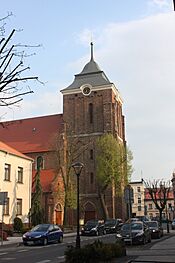
Września was first mentioned in official papers in 1256. Back then, it was called Wressna or Wresna. The town was given special "town privileges" before 1357. This meant it had certain rights, like holding markets.
Września was a "private town," meaning it was owned by different noble families from Poland. It was part of the Kalisz Voivodeship in the Greater Poland region. The town's symbol, its coat of arms, comes from the Poraj family, who were the first owners. Września used to have yearly fairs and weekly markets, which were important for trade. In 1664, the town was burned during a war with Sweden. Most people living there were Polish, but German settlers also arrived in the mid-1600s.
Września Under Prussian Rule
In 1793, Września became part of the Kingdom of Prussia. This happened after Poland was divided up by its neighbors. However, Polish people fought back. After a successful uprising in 1806, Września was briefly part of the Duchy of Warsaw, a Polish state. But in 1815, it went back to Prussia.
Prussia tried to make Poles speak German and follow German customs. This was called "Germanization." To fight this, local Poles created many groups. They also took part in uprisings in 1848 and 1863. In 1848, Polish fighters won a battle against the Prussians near Września, in a village called Sokołowo. By 1875, Września got a railway connection, making it easier to travel to cities like Gniezno and Wrocław. A few years later, in 1882, it also connected to Poznań by train.
The Famous Września School Strike
Września is well-known in Poland for a school strike that happened in May 1901. Prussian authorities made German the only language allowed in schools. Before this, Polish had been allowed. When German became mandatory, Polish children protested.
Teachers severely punished children who refused to speak German. Their parents tried to help them but were also punished by a Prussian court. The court said their actions were "atrocious acts against the state." This strike spread to other towns and lasted until 1904. It showed how strongly Poles resisted Germanization.
Września's Return to Poland
In 1905, Września had about 7,000 people. Most were Poles (65.4%), with Germans (28.9%) and Jews (5.5%) also living there. In the surrounding area, Poles made up an even larger part of the population (85.6%).
Prussian rule ended with the Wielkopolska Uprising in 1918. Soon after, Poland became independent again. In 1920, Września officially rejoined Poland. About 800 local Poles formed the Września Volunteer Legion. They fought against the Soviet invasion to protect their country. Around this time, the district office building was finished. The 68th Infantry Regiment, a military unit, was stationed in Września from 1921.
World War II and Beyond

When World War II began in 1939, German forces took over Września on September 10. The town became part of a German-controlled area. The Germans arrested many local Poles. They were put in prison and later killed in massacres in nearby forests in late 1939. Many Poles were also forced to leave their homes.
Despite this, the Polish resistance stayed active. The synagogue in Września was destroyed in 1940. A camp for French prisoners of war was also in the area. From 1941 to 1943, a forced labor camp for Jewish people operated near the town. After the war ended and the Red Army arrived, Września became part of the People's Republic of Poland.
In 1979, a monument to Maria Konopnicka was unveiled in Września. She was a famous Polish poet and writer who supported the Września schoolchildren during their strike.
Jewish Community in Września
Września was home to a notable Jewish community. Important religious scholars lived here. These included Rabbi Ẓebi Hirsch and his father, Rabbi Aaron Mirels. The famous Bible expert, Rabbi Meïr Löb Malbim, also lived in Września. He wrote his first important work here. Another notable person born in Września was Louis Lewandowski, a well-known musical director, born in 1821.
Places to See in Września
Września has many interesting places to visit:
- The Gothic Church of the Assumption of Mary, a beautiful old church.
- The Holy Cross Church.
- The historic Town Hall.
- The Rynek, or Market Square, which has colorful old buildings.
- Park im. Marszałka Józefa Piłsudskiego.
- The Monument to Września Children, remembering the school strike.
- Poniński Palace, which is next to the Children of Września Park.
- The Maria Konopnicka Monument.
- World War II memorials, including one for the Katyń massacre and another for the 68th Infantry Regiment.
- Graves of Polish fighters from the 1848 and 1918–1919 uprisings at the local cemetery.
- Wrzesińskie Lake, a nice place to relax.
- The Holy Spirit church.
- The District office building.
- The Courthouse.
Education in Września
Września has several places for higher education:
- Wyższa Szkoła Handlu i Rachunkowości w Poznaniu, Wydział Zamiejscowy we Wrześni (a branch of a business and accounting school).
- Akademia Kaliska im. Prezydenta Stanisława Wojciechowskiego w Kaliszu, Wydział Medyczno-Społeczno-Techniczny we Wrześni (a branch of a medical, social, and technical academy).
Getting Around Września
The main Września railway station is in the town. There were also two old narrow-gauge railway stations, Września Miasto and Września Wąskotorowa, but they are no longer in use.
Local Food and Cuisine
Września is known for producing Greater Poland liliput cheese (ser liliput wielkopolski). This is a traditional regional Polish cheese. It is protected as a traditional food by the Polish Ministry of Agriculture.
Sports in Września
Września has various sports activities and teams.
Famous People from Września
Many notable people were born or lived in Września:
- Friedrich-Wilhelm Bock (1897–1978), a general.
- Zygmunt Gorgolewski (1845–1903), an architect.
- Łukasz Koszarek (born 1984), a basketball player.
- Jarosław Kukulski (1944–2010), a composer.
- Louis Lewandowski (1821–1894), a musician.
- Peter J. Lucas (born 1962), an actor.
- Malbim (1809–1879), a rabbi and Bible expert.



